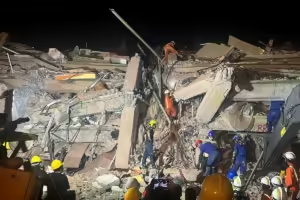NAYPYITAW, MYANMAR – A 63-year-old woman was pulled from the rubble in Myanmar’s capital on Tuesday, 91 hours after a devastating earthquake struck the country, but hopes of finding more survivors are fading. The 7.7-magnitude quake, which hit on Friday, has left at least 2,719 dead, worsening an already dire humanitarian crisis caused by ongoing civil conflict.
Search Efforts Face Challenges as Death Toll Rises
Myanmar’s military leader, Senior General Min Aung Hlaing, confirmed that in addition to the fatalities, 4,521 people have been injured, and 441 remain missing, according to Myanmar’s Western News online portal. However, the final toll is expected to be significantly higher, as large portions of the country remain inaccessible due to damaged infrastructure and communication blackouts.
The hardest-hit areas include Mandalay, Myanmar’s second-largest city, and Naypyitaw, the capital. UNICEF’s deputy representative for Myanmar, Julia Rees, described the situation as critical:
“The needs are massive and growing by the hour. The window for a life-saving response is closing, and families in affected areas are facing severe shortages of clean water, food, and medical supplies.”
The nation’s fire department has reported that 403 people have been rescued in Mandalay alone, while 259 bodies have been recovered. Among the dead are 50 Buddhist monks who perished when their monastery collapsed during an exam, with 150 more feared buried beneath the debris.
Widespread Destruction and Regional Impact
The World Health Organization estimates that over 10,000 buildings across central and northwest Myanmar have either collapsed or sustained severe damage. The earthquake’s impact extended beyond Myanmar, with neighboring Thailand also experiencing structural failures. A high-rise under construction in Bangkok collapsed, killing at least 21 people and injuring 34 others.
International Aid Efforts and Challenges
Search and rescue operations in Myanmar have been slow due to a lack of heavy machinery. In some locations, workers have resorted to forming human chains, passing debris piece by piece. However, international rescue teams from China, Russia, India, the UAE, and several Southeast Asian nations have joined the efforts.
China’s rescue team made a breakthrough on Monday, pulling four people—including a 5-year-old child and a pregnant woman—from the ruins of a collapsed apartment complex. Two teenagers managed to crawl out of the same wreckage using their phone flashlights to signal for help, allowing rescuers to locate their trapped relatives.
Despite the influx of aid, Myanmar’s political turmoil is complicating relief efforts. The country has been embroiled in a civil war since the military seized power in 2021. Many regions were already difficult to access before the disaster due to ongoing conflict.
The shadow opposition government, the National Unity Government (NUG), has called for an international push to ensure humanitarian aid reaches those in need, warning against interference from Myanmar’s military.
“We are in a race against time to save lives,” the NUG said in a statement. “Any obstruction to these efforts will have devastating consequences, not only due to the earthquake’s impact but also because of the junta’s continued brutality.”

Risk of Disease and Looming Monsoon Season
With tens of thousands left homeless and forced to sleep outdoors, the risk of disease outbreaks is growing. The UN Office for the Coordination of Humanitarian Affairs (OCHA) has warned of potential epidemics due to the destruction of sanitation infrastructure, particularly as Myanmar approaches monsoon season.
“The combination of overcrowded shelters and a lack of clean water has significantly increased the risk of outbreaks, including respiratory infections, skin diseases, dengue fever, and measles,” OCHA stated.
Even before the earthquake, nearly 20 million people in Myanmar were in need of humanitarian assistance, and over 3 million had been displaced by the civil war. The disaster has only deepened the crisis, leaving survivors in desperate need of food, medical aid, and shelter.
Despite historical resistance to foreign aid, Myanmar’s military leader has said the country will accept international assistance. However, concerns remain over whether aid will reach those most in need or be restricted by the military.
Tom Andrews, a UN human rights monitor for Myanmar, emphasized the urgency of the situation in a social media post:
“The focus in Myanmar must be on saving lives, not taking them.”
As rescue operations continue, the full scale of the disaster is yet to unfold. With time running out and aftershocks still a threat, Myanmar’s already fragile situation has entered an even more precarious phase.










































